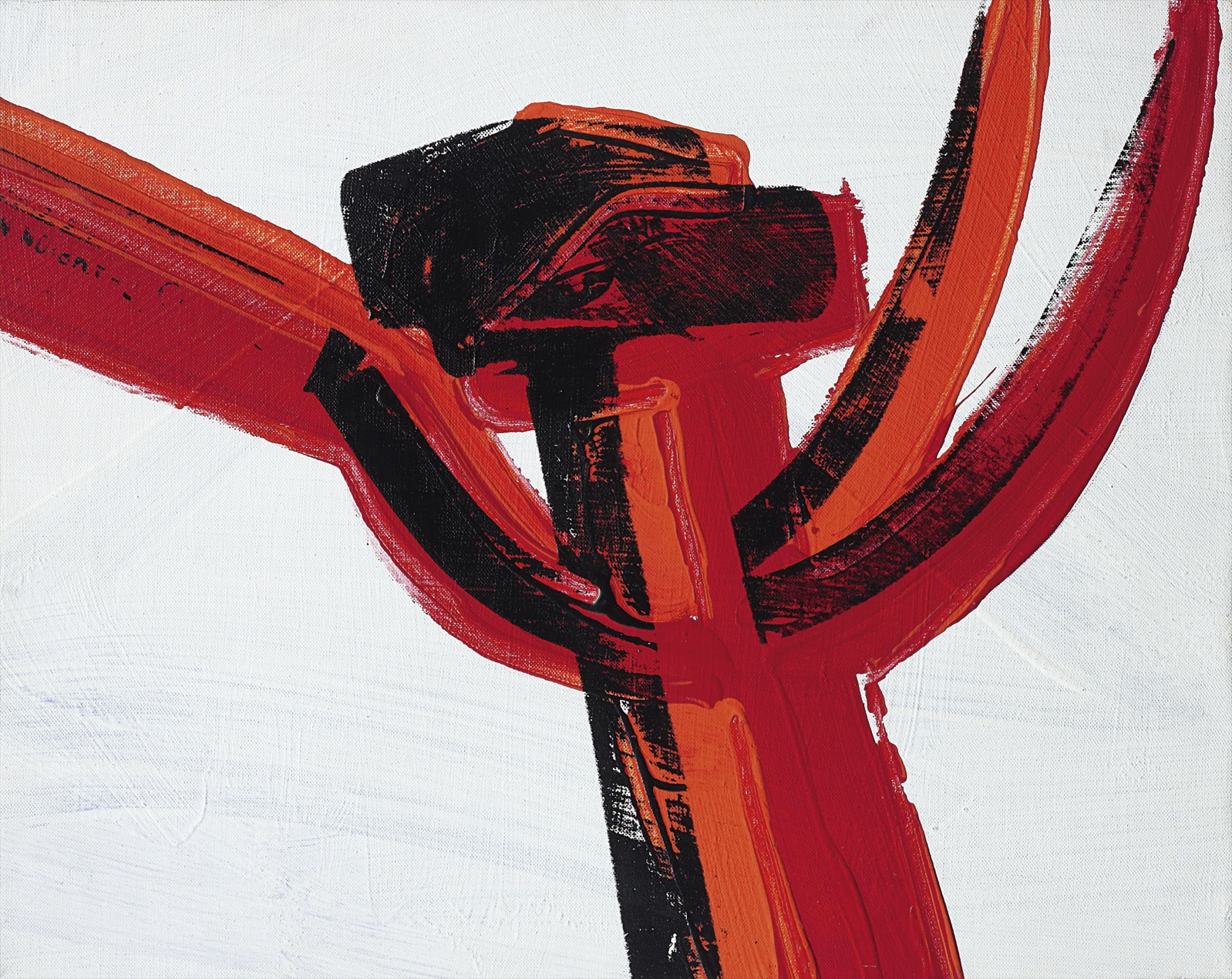

11
Andy Warhol
Hammer and Sickle
Full-Cataloguing
"Everybody’s always asking me if I’m a Communist because I’ve done Mao. So now I’m doing hammers and sickles for Communism, and skulls for Fascism.” Andy Warhol
"To Andy, they were also an extension of the classic still life. For years I had been photographing still lives for Andy … he loved to experiment and update classical themes. For him, it was the best part of making art.” (R. Cutrone, ‘Hammer and Sickle’, Andy Warhol: Hammer and Sickle, exh. cat., London: Haunch of Venison, 2004, p. 5)
The present lot, executed in 1977, is a unique example of Andy Warhol’s famous Hammer and Sickle series. It was first exhibited under the title Still Lifes at New York’s Leo Castelli Gallery in 1977, and is dedicated to Warhol’s friend Bob Colacello, who edited the artist’s celebrity magazine Interview for 12 years.
With Hammer and Sickle, Warhol proves once again to be the premier iconoclast of the 20th century, demonstrating his unique ability to raise ideological, historical and social issues within a single striking image. Engaging with the Communist symbol and with the classic colours of Soviet propaganda – white, black and red – Warhol deprives the hammer and sickle of its usual stern aura and transforms it into an attractive consumerist object, on a par with his earlier Coca-Cola cans and Brillo Soap Pad boxes. However, this time the subject is not a product of American capitalism, but its exact opposite, the emblem of Communist ideology. If his first controversial Brillo Soap Pad boxes were aimed at destabilising the threshold between high and low culture – undermining Clement Greenberg’s modernist separation of art and kitsch –Hammer and Sickle goes even further in conflating mass-produced imagery with propaganda. To Warhol, both the Brillo Soap Pad boxes and the hammer and sickle are nothing more than items made to sell: whether an object or an idea, it makes no difference.
First adopted by the Red Army and later incorporated into the Soviet Union’s national flag, the crossed hammer and sickle were meant to symbolise unity between industrial and agricultural labourers working together for the state. For his Hammer and Sickle series, Warhol dismantled this Communist icon into its components, arranging the tools into different compositions which were then photographed by his assistant Ronnie Cutrone. Inspired by Italian hammer and sickle graffiti seen during a trip to Naples, Warhol had originally asked Cutrone to track down images of the symbol in local bookstores. But the book images proved to be, in his words, too flat or too graphic, as Cutrone recalls: “The answer was to go down to Canal Street, into a hardware store, and buy a real hammer and sickle. Then I could shoot them, lit with long, menacing shadows, and add the drama that was missing from the flat-stencilled book versions… It always amused me that Andy, the ultimate Capitalist, and me, the ultimate Libertarian, could be suspected of Communist activity” (Hammer and Sickle, exh. cat., New York, C&M Arts, 2002). The result was a large body of work – comprising paint and silkscreen on canvas, drawings and collages – in which the artist experimented with different solutions, just as if moving objects in an ordinary still life composition.
If considering Hammer and Sickle as a contemporary version of the typical 18thcentury still life genre, the present work becomes a memento mori, a reminder of the horrors of war and dictatorships. Although the same may be said for Warhol’s Skull series – and perhaps more generally for his Guns and Knives – the artist has here approached Communist iconography with a slightly greater sense of irony. A closer look at the handle of the sickle reveals the words “Champion no. 15 by True Temper”, the logo of the American manufacturer. Is Warhol mocking the American liberal market, or communism? Or both? The difference between capitalism and communism, between ‘good’ and ‘bad’, is irretrievably blurred. Warhol demotes the hammer and the sickle to mere objects and, with his knowing eye, transforms them still further into strikingly beautiful abstract images.
Andy Warhol
American | B. 1928 D. 1987Andy Warhol was the leading exponent of the Pop Art movement in the U.S. in the 1960s. Following an early career as a commercial illustrator, Warhol achieved fame with his revolutionary series of silkscreened prints and paintings of familiar objects, such as Campbell's soup tins, and celebrities, such as Marilyn Monroe. Obsessed with popular culture, celebrity and advertising, Warhol created his slick, seemingly mass-produced images of everyday subject matter from his famed Factory studio in New York City. His use of mechanical methods of reproduction, notably the commercial technique of silk screening, wholly revolutionized art-making.
Working as an artist, but also director and producer, Warhol produced a number of avant-garde films in addition to managing the experimental rock band The Velvet Underground and founding Interview magazine. A central figure in the New York art scene until his untimely death in 1987, Warhol was notably also a mentor to such artists as Keith Haring and Jean-Michel Basquiat.